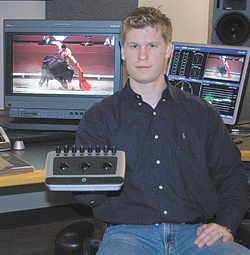Quantel Keeps 'Matador's' Colors True
by Ian Rummer
Senior Editor
TEAM
WASHINGTON
David Fandila is one of the best-known bullfighters in the world and the focus of a new documentary that I edited and finished called, "The Matador." It opened the end of October at the Angelika Film Center in New York.

Ian Rummer'FILM TREATMENT' DESIRED
Producer and co-director Nina Gilden Seavey felt that this film needed a very big "film treatment." The artistry in the story of David's commitment and passion for bullfighting was mirrored in the cinematography and orchestral score. The editorial had to tie it all together and provide an emotional experience for the audience.
Nina and I have worked on several films in the past and she tapped me to help bring "The Matador" to its full potential. I off-lined the film in Final Cut Pro and then switched hats to assume on-line and color correction duties. For this film, the color correction was as important as the editorial.
There was a lot of demand on the refinement phase of this project and that's when I turned to the Quantel eQ system with QColor to get the job done. The eQ is a robust platform that provides advanced tools for each stage of the post process including editorial, mixed format management, keying and compositing, tracking and color correction.
The main decision to bring "The Matador" into the eQ was based on the system's color correction capabilities. The other important feature the eQ brought to the table was its multi-formatting capability. The primary content source for this production was HDCAM 23.98 PsF material. There were also high-definition 29.97i sources, NTSC, PAL, stills and QuickTime movies. The eQ not only accommodated the variety of formats, but also provided extremely high conversion and processing quality.
COLOR CORRECTION IS A BIG ISSUE
One of the reasons color correction was so challenging is that bullfights start at 5 p.m. when the light is soft and then begins to change dramatically. Continuity was an issue when condensing bullfights taking place during a long period of time into a couple of minutes.
The goal was to create a balanced contrast that emphasized the detail in the shadows while protecting the brighter areas. This is difficult to achieve without crushing the blacks and clipping the highlights, which results in significant information loss.
The eQ provided a unique, comprehensive solution to tackle the individual challenges of each shot. Many times, I used the HSL keyer to pull a luminance key and protect bright areas from the corrections made to the shadows, and then would do a second correction on those protected, brighter areas. The color grading tools combined with the keying, compositing, tracking and animation abilities of the eQ offer a toolset you don't get in traditional color correction suites.
Ian Rummer is a senior editor at TEAM, a Washington, D.C. company that provides video and audio postproduction and other services. He has been with the company since 2003 and may be contacted at irummer@teamgroup.tv.
For additional information, contact Quantel at 201-951-7246 or visit www.quantel.com.
The professional video industry's #1 source for news, trends and product and tech information. Sign up below.
